Airline Pricing Strategy: Analysis of Key Factors and Implications
VerifiedAdded on 2020/03/04
|15
|2761
|55
Report
AI Summary
This report delves into the pricing strategies employed by the airline industry, focusing on how airlines maximize revenue through yield management and price discrimination. It examines the concept of charging different prices for the same seat based on factors like booking time, class, and customer type, and explains how airlines differentiate buyers based on their willingness to pay. The report also discusses the influence of substitute and complementary goods on ticket prices, along with the factors affecting airline demand and prices over time, such as fuel costs, economic growth, and changing demographics. Furthermore, it analyzes the welfare implications of these pricing strategies, including consumer and producer surplus, and suggests potential areas for public intervention, such as relaxing entry barriers and regulating fares to promote competition and ensure consumer benefits. The report provides examples of pricing strategies used by major airlines like Singapore Airlines, Air Asia, and Jetstar, and concludes by emphasizing the importance of price discrimination in the airline market and the various factors influencing ticket prices.
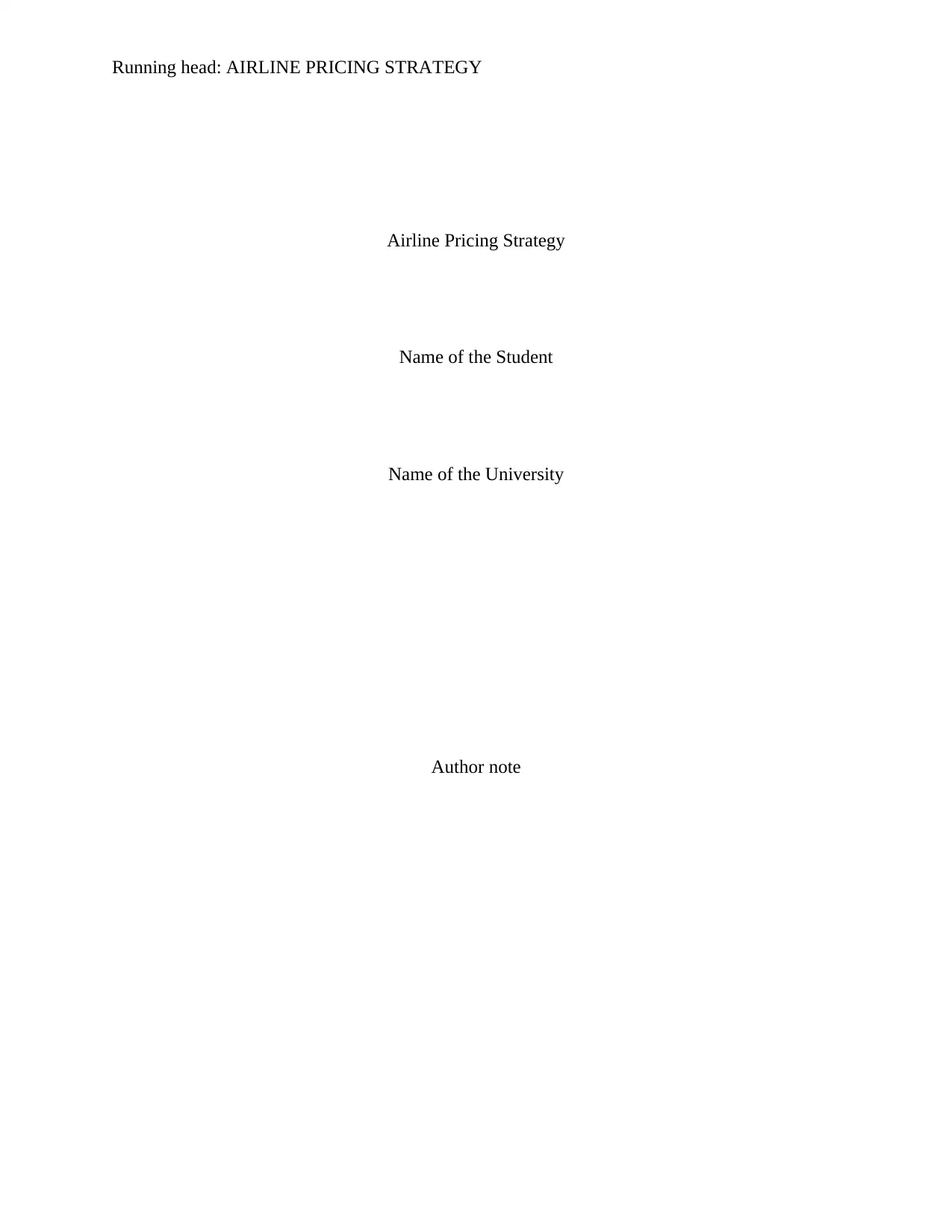
Running head: AIRLINE PRICING STRATEGY
Airline Pricing Strategy
Name of the Student
Name of the University
Author note
Airline Pricing Strategy
Name of the Student
Name of the University
Author note
Paraphrase This Document
Need a fresh take? Get an instant paraphrase of this document with our AI Paraphraser
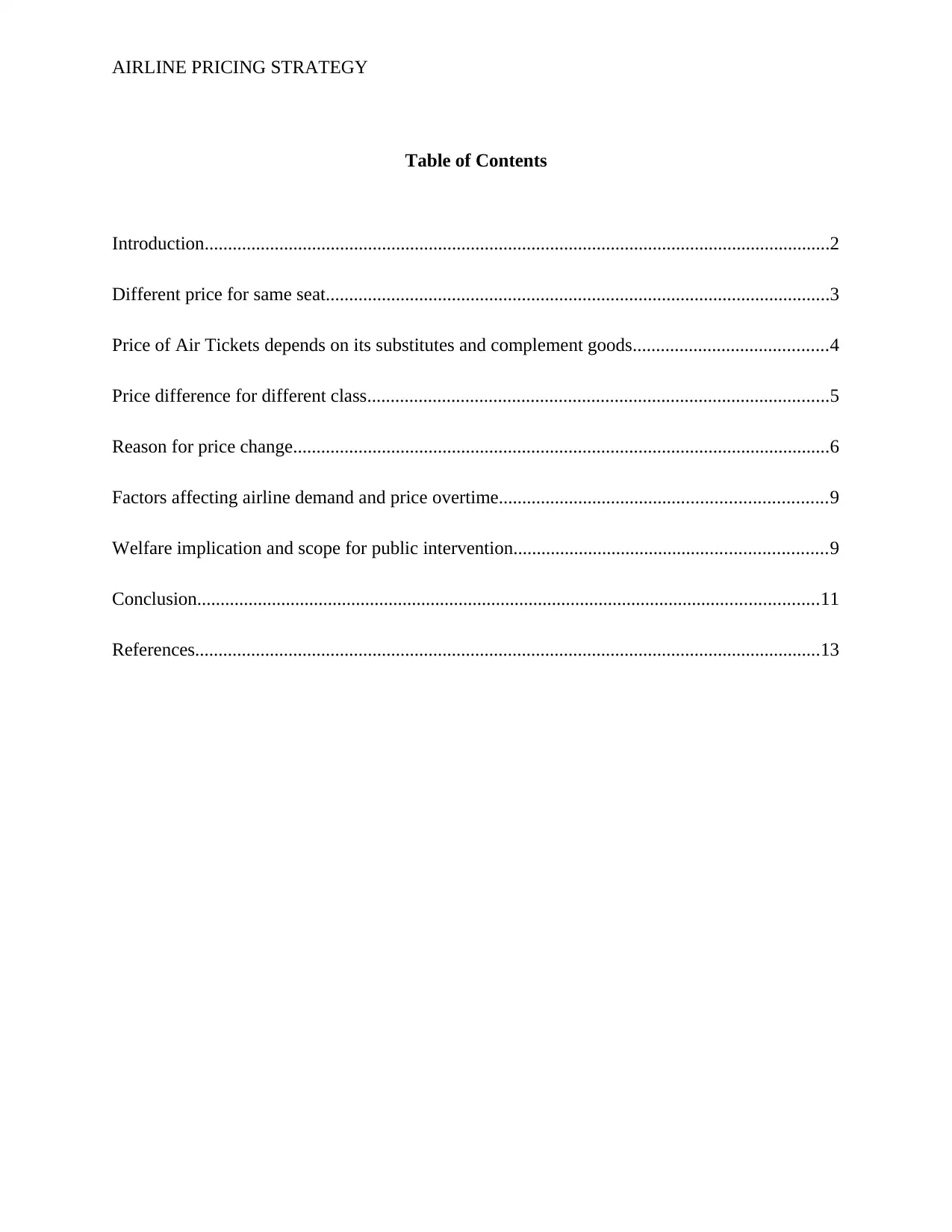
AIRLINE PRICING STRATEGY
Table of Contents
Introduction......................................................................................................................................2
Different price for same seat............................................................................................................3
Price of Air Tickets depends on its substitutes and complement goods..........................................4
Price difference for different class...................................................................................................5
Reason for price change...................................................................................................................6
Factors affecting airline demand and price overtime......................................................................9
Welfare implication and scope for public intervention...................................................................9
Conclusion.....................................................................................................................................11
References......................................................................................................................................13
Table of Contents
Introduction......................................................................................................................................2
Different price for same seat............................................................................................................3
Price of Air Tickets depends on its substitutes and complement goods..........................................4
Price difference for different class...................................................................................................5
Reason for price change...................................................................................................................6
Factors affecting airline demand and price overtime......................................................................9
Welfare implication and scope for public intervention...................................................................9
Conclusion.....................................................................................................................................11
References......................................................................................................................................13
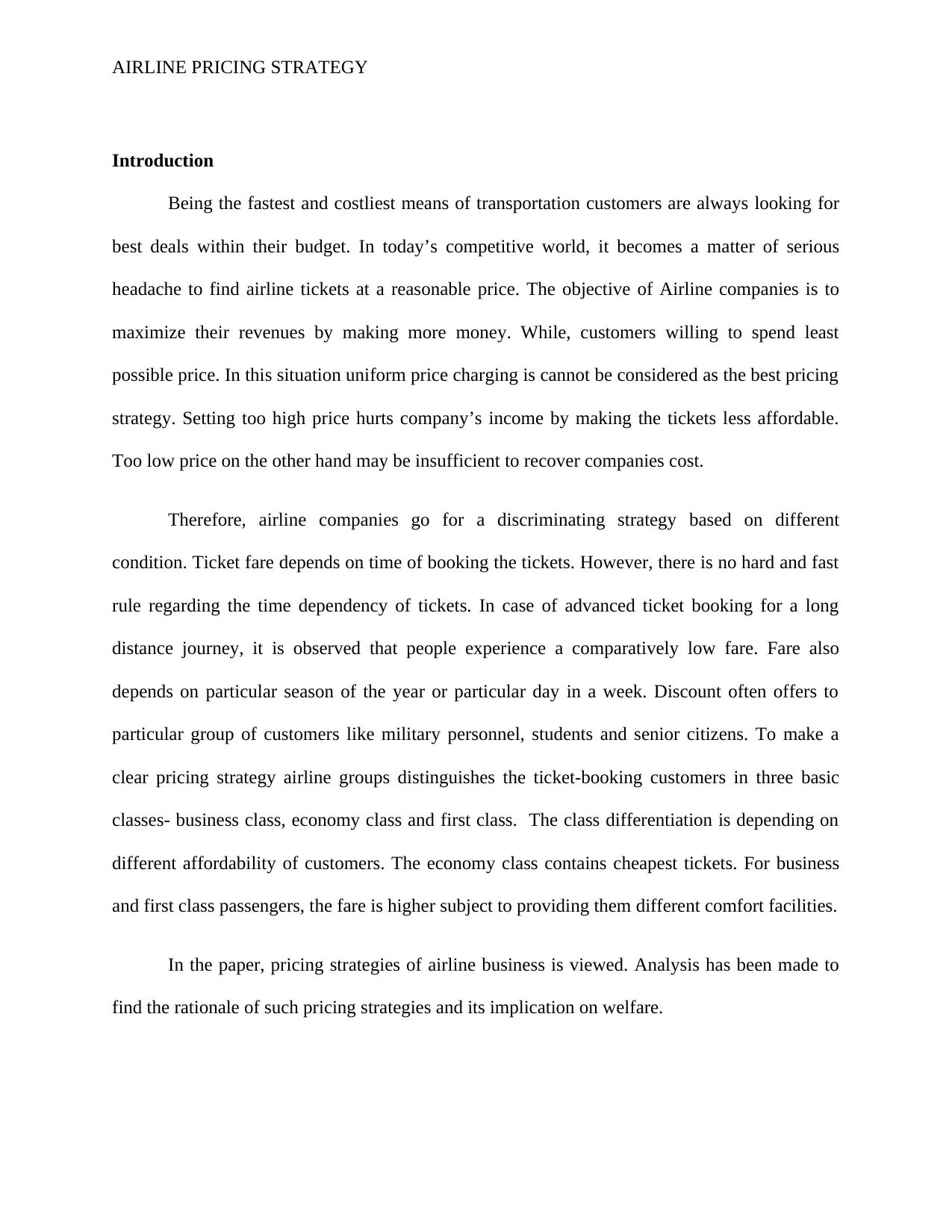
AIRLINE PRICING STRATEGY
Introduction
Being the fastest and costliest means of transportation customers are always looking for
best deals within their budget. In today’s competitive world, it becomes a matter of serious
headache to find airline tickets at a reasonable price. The objective of Airline companies is to
maximize their revenues by making more money. While, customers willing to spend least
possible price. In this situation uniform price charging is cannot be considered as the best pricing
strategy. Setting too high price hurts company’s income by making the tickets less affordable.
Too low price on the other hand may be insufficient to recover companies cost.
Therefore, airline companies go for a discriminating strategy based on different
condition. Ticket fare depends on time of booking the tickets. However, there is no hard and fast
rule regarding the time dependency of tickets. In case of advanced ticket booking for a long
distance journey, it is observed that people experience a comparatively low fare. Fare also
depends on particular season of the year or particular day in a week. Discount often offers to
particular group of customers like military personnel, students and senior citizens. To make a
clear pricing strategy airline groups distinguishes the ticket-booking customers in three basic
classes- business class, economy class and first class. The class differentiation is depending on
different affordability of customers. The economy class contains cheapest tickets. For business
and first class passengers, the fare is higher subject to providing them different comfort facilities.
In the paper, pricing strategies of airline business is viewed. Analysis has been made to
find the rationale of such pricing strategies and its implication on welfare.
Introduction
Being the fastest and costliest means of transportation customers are always looking for
best deals within their budget. In today’s competitive world, it becomes a matter of serious
headache to find airline tickets at a reasonable price. The objective of Airline companies is to
maximize their revenues by making more money. While, customers willing to spend least
possible price. In this situation uniform price charging is cannot be considered as the best pricing
strategy. Setting too high price hurts company’s income by making the tickets less affordable.
Too low price on the other hand may be insufficient to recover companies cost.
Therefore, airline companies go for a discriminating strategy based on different
condition. Ticket fare depends on time of booking the tickets. However, there is no hard and fast
rule regarding the time dependency of tickets. In case of advanced ticket booking for a long
distance journey, it is observed that people experience a comparatively low fare. Fare also
depends on particular season of the year or particular day in a week. Discount often offers to
particular group of customers like military personnel, students and senior citizens. To make a
clear pricing strategy airline groups distinguishes the ticket-booking customers in three basic
classes- business class, economy class and first class. The class differentiation is depending on
different affordability of customers. The economy class contains cheapest tickets. For business
and first class passengers, the fare is higher subject to providing them different comfort facilities.
In the paper, pricing strategies of airline business is viewed. Analysis has been made to
find the rationale of such pricing strategies and its implication on welfare.
⊘ This is a preview!⊘
Do you want full access?
Subscribe today to unlock all pages.

Trusted by 1+ million students worldwide
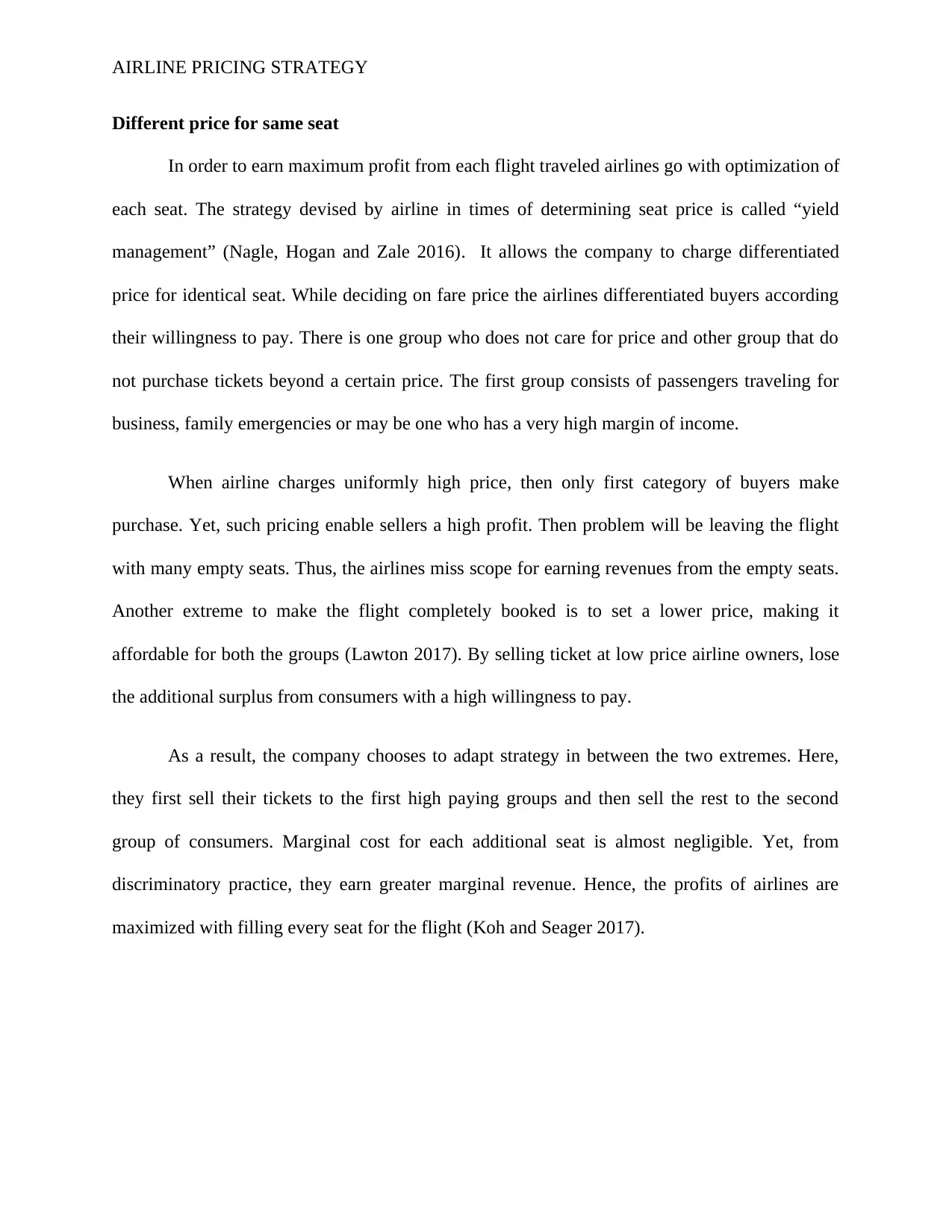
AIRLINE PRICING STRATEGY
Different price for same seat
In order to earn maximum profit from each flight traveled airlines go with optimization of
each seat. The strategy devised by airline in times of determining seat price is called “yield
management” (Nagle, Hogan and Zale 2016). It allows the company to charge differentiated
price for identical seat. While deciding on fare price the airlines differentiated buyers according
their willingness to pay. There is one group who does not care for price and other group that do
not purchase tickets beyond a certain price. The first group consists of passengers traveling for
business, family emergencies or may be one who has a very high margin of income.
When airline charges uniformly high price, then only first category of buyers make
purchase. Yet, such pricing enable sellers a high profit. Then problem will be leaving the flight
with many empty seats. Thus, the airlines miss scope for earning revenues from the empty seats.
Another extreme to make the flight completely booked is to set a lower price, making it
affordable for both the groups (Lawton 2017). By selling ticket at low price airline owners, lose
the additional surplus from consumers with a high willingness to pay.
As a result, the company chooses to adapt strategy in between the two extremes. Here,
they first sell their tickets to the first high paying groups and then sell the rest to the second
group of consumers. Marginal cost for each additional seat is almost negligible. Yet, from
discriminatory practice, they earn greater marginal revenue. Hence, the profits of airlines are
maximized with filling every seat for the flight (Koh and Seager 2017).
Different price for same seat
In order to earn maximum profit from each flight traveled airlines go with optimization of
each seat. The strategy devised by airline in times of determining seat price is called “yield
management” (Nagle, Hogan and Zale 2016). It allows the company to charge differentiated
price for identical seat. While deciding on fare price the airlines differentiated buyers according
their willingness to pay. There is one group who does not care for price and other group that do
not purchase tickets beyond a certain price. The first group consists of passengers traveling for
business, family emergencies or may be one who has a very high margin of income.
When airline charges uniformly high price, then only first category of buyers make
purchase. Yet, such pricing enable sellers a high profit. Then problem will be leaving the flight
with many empty seats. Thus, the airlines miss scope for earning revenues from the empty seats.
Another extreme to make the flight completely booked is to set a lower price, making it
affordable for both the groups (Lawton 2017). By selling ticket at low price airline owners, lose
the additional surplus from consumers with a high willingness to pay.
As a result, the company chooses to adapt strategy in between the two extremes. Here,
they first sell their tickets to the first high paying groups and then sell the rest to the second
group of consumers. Marginal cost for each additional seat is almost negligible. Yet, from
discriminatory practice, they earn greater marginal revenue. Hence, the profits of airlines are
maximized with filling every seat for the flight (Koh and Seager 2017).
Paraphrase This Document
Need a fresh take? Get an instant paraphrase of this document with our AI Paraphraser
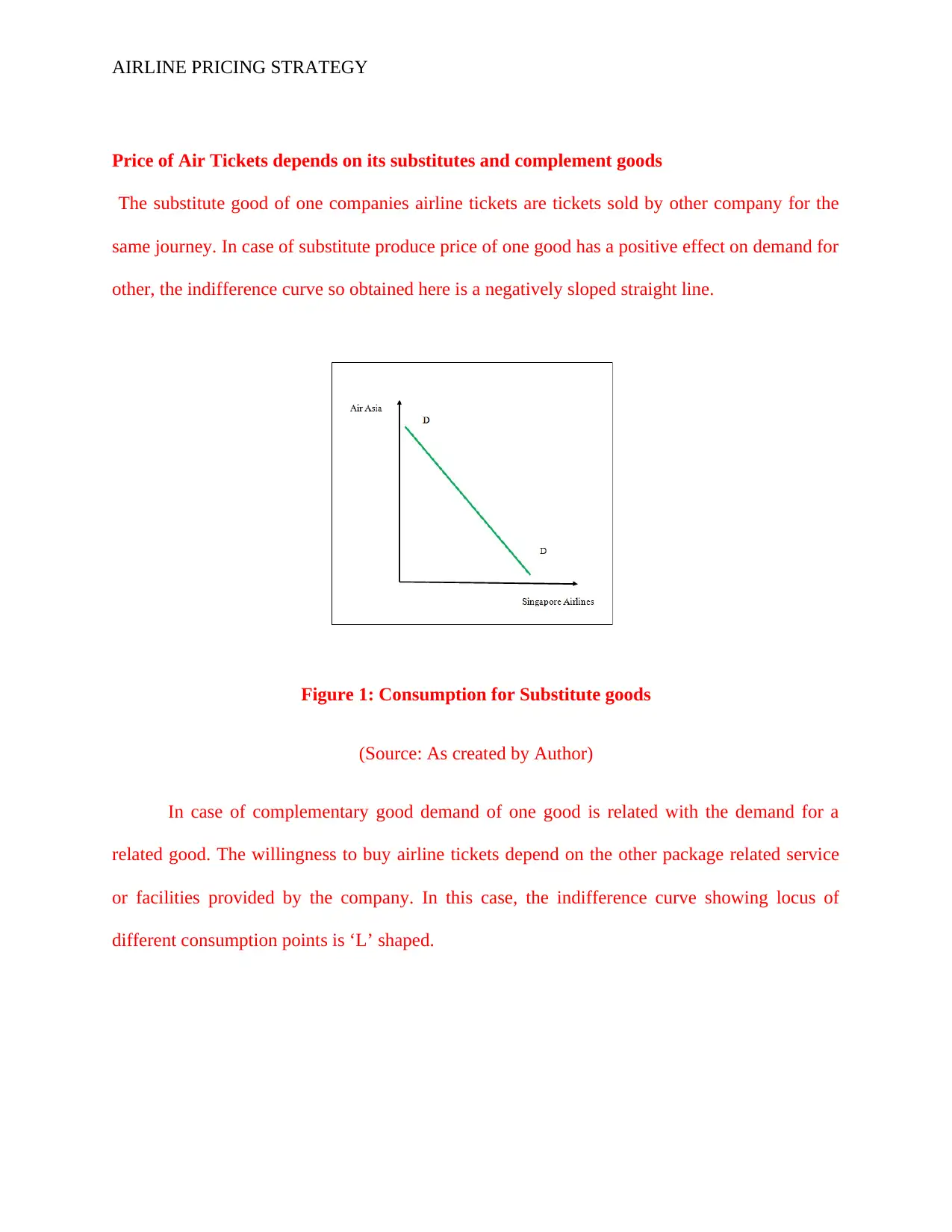
AIRLINE PRICING STRATEGY
Price of Air Tickets depends on its substitutes and complement goods
The substitute good of one companies airline tickets are tickets sold by other company for the
same journey. In case of substitute produce price of one good has a positive effect on demand for
other, the indifference curve so obtained here is a negatively sloped straight line.
Figure 1: Consumption for Substitute goods
(Source: As created by Author)
In case of complementary good demand of one good is related with the demand for a
related good. The willingness to buy airline tickets depend on the other package related service
or facilities provided by the company. In this case, the indifference curve showing locus of
different consumption points is ‘L’ shaped.
Price of Air Tickets depends on its substitutes and complement goods
The substitute good of one companies airline tickets are tickets sold by other company for the
same journey. In case of substitute produce price of one good has a positive effect on demand for
other, the indifference curve so obtained here is a negatively sloped straight line.
Figure 1: Consumption for Substitute goods
(Source: As created by Author)
In case of complementary good demand of one good is related with the demand for a
related good. The willingness to buy airline tickets depend on the other package related service
or facilities provided by the company. In this case, the indifference curve showing locus of
different consumption points is ‘L’ shaped.
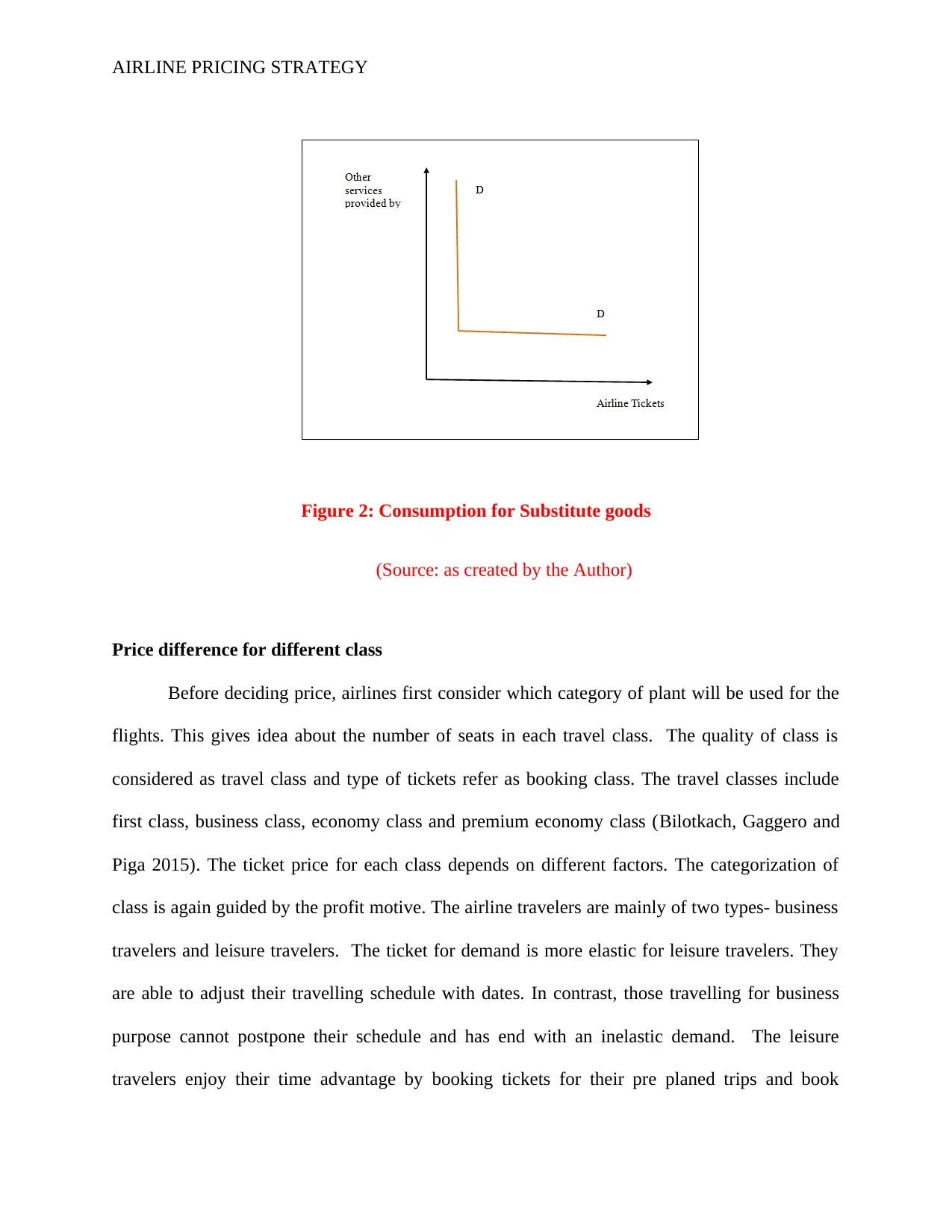
AIRLINE PRICING STRATEGY
Figure 2: Consumption for Substitute goods
(Source: as created by the Author)
Price difference for different class
Before deciding price, airlines first consider which category of plant will be used for the
flights. This gives idea about the number of seats in each travel class. The quality of class is
considered as travel class and type of tickets refer as booking class. The travel classes include
first class, business class, economy class and premium economy class (Bilotkach, Gaggero and
Piga 2015). The ticket price for each class depends on different factors. The categorization of
class is again guided by the profit motive. The airline travelers are mainly of two types- business
travelers and leisure travelers. The ticket for demand is more elastic for leisure travelers. They
are able to adjust their travelling schedule with dates. In contrast, those travelling for business
purpose cannot postpone their schedule and has end with an inelastic demand. The leisure
travelers enjoy their time advantage by booking tickets for their pre planed trips and book
Figure 2: Consumption for Substitute goods
(Source: as created by the Author)
Price difference for different class
Before deciding price, airlines first consider which category of plant will be used for the
flights. This gives idea about the number of seats in each travel class. The quality of class is
considered as travel class and type of tickets refer as booking class. The travel classes include
first class, business class, economy class and premium economy class (Bilotkach, Gaggero and
Piga 2015). The ticket price for each class depends on different factors. The categorization of
class is again guided by the profit motive. The airline travelers are mainly of two types- business
travelers and leisure travelers. The ticket for demand is more elastic for leisure travelers. They
are able to adjust their travelling schedule with dates. In contrast, those travelling for business
purpose cannot postpone their schedule and has end with an inelastic demand. The leisure
travelers enjoy their time advantage by booking tickets for their pre planed trips and book
⊘ This is a preview!⊘
Do you want full access?
Subscribe today to unlock all pages.

Trusted by 1+ million students worldwide
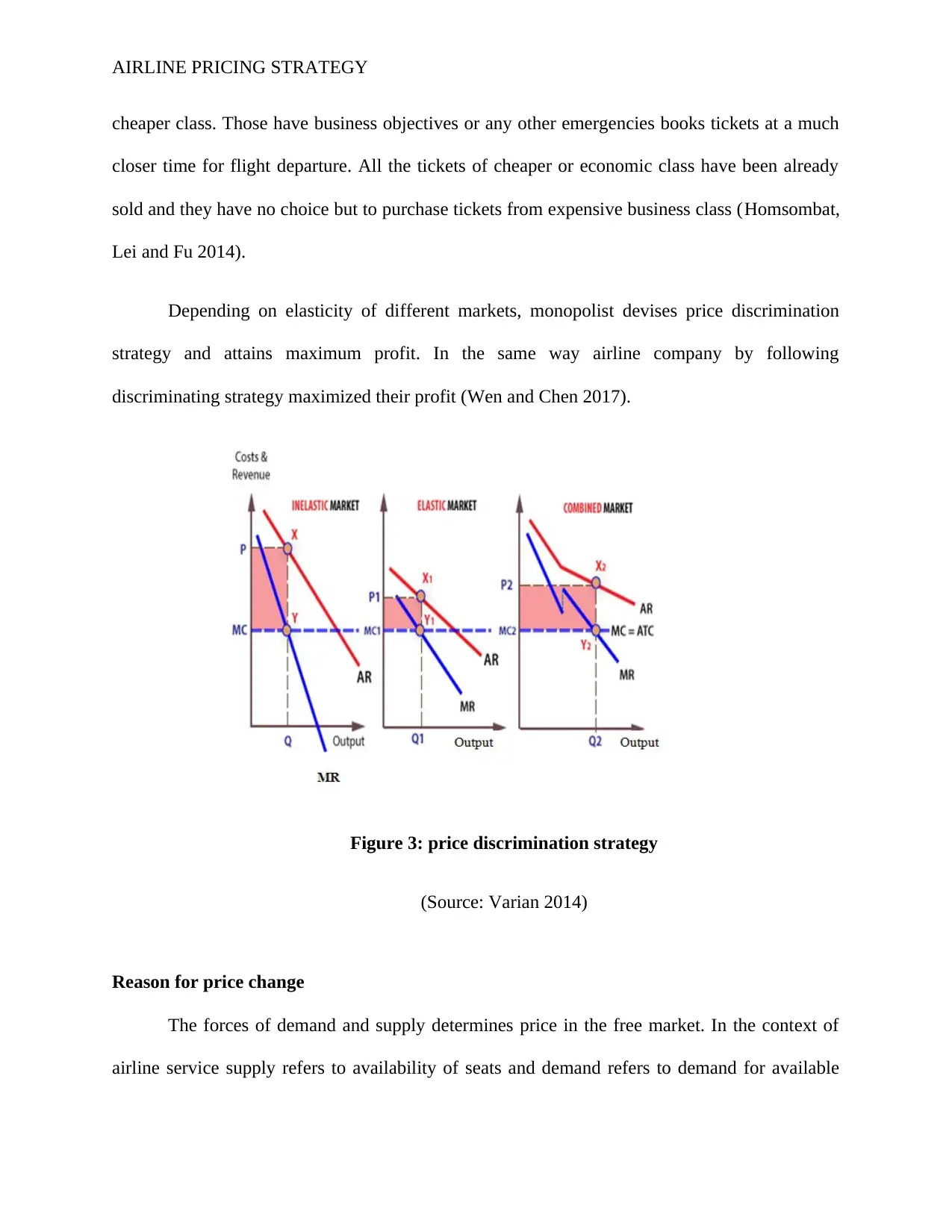
AIRLINE PRICING STRATEGY
cheaper class. Those have business objectives or any other emergencies books tickets at a much
closer time for flight departure. All the tickets of cheaper or economic class have been already
sold and they have no choice but to purchase tickets from expensive business class (Homsombat,
Lei and Fu 2014).
Depending on elasticity of different markets, monopolist devises price discrimination
strategy and attains maximum profit. In the same way airline company by following
discriminating strategy maximized their profit (Wen and Chen 2017).
Figure 3: price discrimination strategy
(Source: Varian 2014)
Reason for price change
The forces of demand and supply determines price in the free market. In the context of
airline service supply refers to availability of seats and demand refers to demand for available
cheaper class. Those have business objectives or any other emergencies books tickets at a much
closer time for flight departure. All the tickets of cheaper or economic class have been already
sold and they have no choice but to purchase tickets from expensive business class (Homsombat,
Lei and Fu 2014).
Depending on elasticity of different markets, monopolist devises price discrimination
strategy and attains maximum profit. In the same way airline company by following
discriminating strategy maximized their profit (Wen and Chen 2017).
Figure 3: price discrimination strategy
(Source: Varian 2014)
Reason for price change
The forces of demand and supply determines price in the free market. In the context of
airline service supply refers to availability of seats and demand refers to demand for available
Paraphrase This Document
Need a fresh take? Get an instant paraphrase of this document with our AI Paraphraser
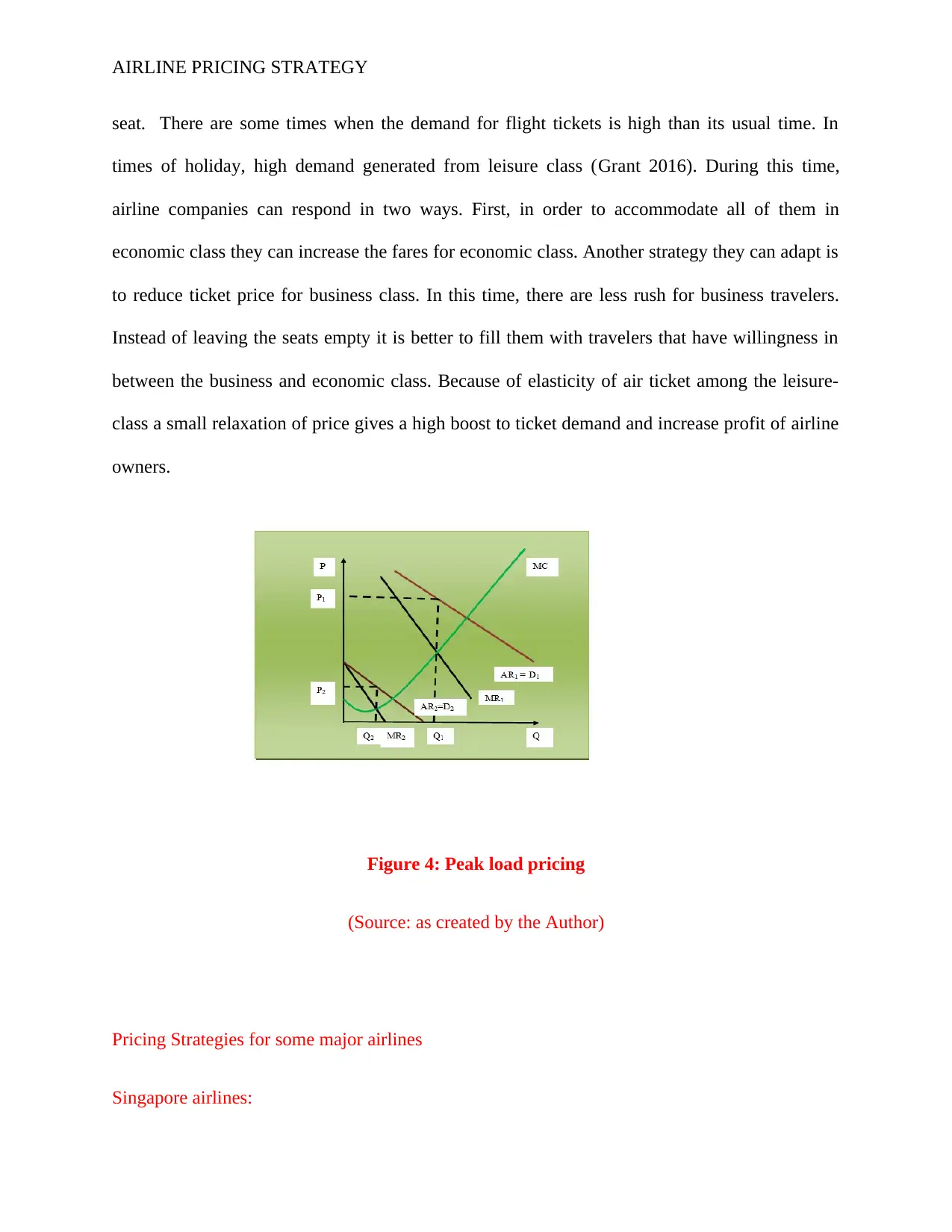
AIRLINE PRICING STRATEGY
seat. There are some times when the demand for flight tickets is high than its usual time. In
times of holiday, high demand generated from leisure class (Grant 2016). During this time,
airline companies can respond in two ways. First, in order to accommodate all of them in
economic class they can increase the fares for economic class. Another strategy they can adapt is
to reduce ticket price for business class. In this time, there are less rush for business travelers.
Instead of leaving the seats empty it is better to fill them with travelers that have willingness in
between the business and economic class. Because of elasticity of air ticket among the leisure-
class a small relaxation of price gives a high boost to ticket demand and increase profit of airline
owners.
Figure 4: Peak load pricing
(Source: as created by the Author)
Pricing Strategies for some major airlines
Singapore airlines:
seat. There are some times when the demand for flight tickets is high than its usual time. In
times of holiday, high demand generated from leisure class (Grant 2016). During this time,
airline companies can respond in two ways. First, in order to accommodate all of them in
economic class they can increase the fares for economic class. Another strategy they can adapt is
to reduce ticket price for business class. In this time, there are less rush for business travelers.
Instead of leaving the seats empty it is better to fill them with travelers that have willingness in
between the business and economic class. Because of elasticity of air ticket among the leisure-
class a small relaxation of price gives a high boost to ticket demand and increase profit of airline
owners.
Figure 4: Peak load pricing
(Source: as created by the Author)
Pricing Strategies for some major airlines
Singapore airlines:
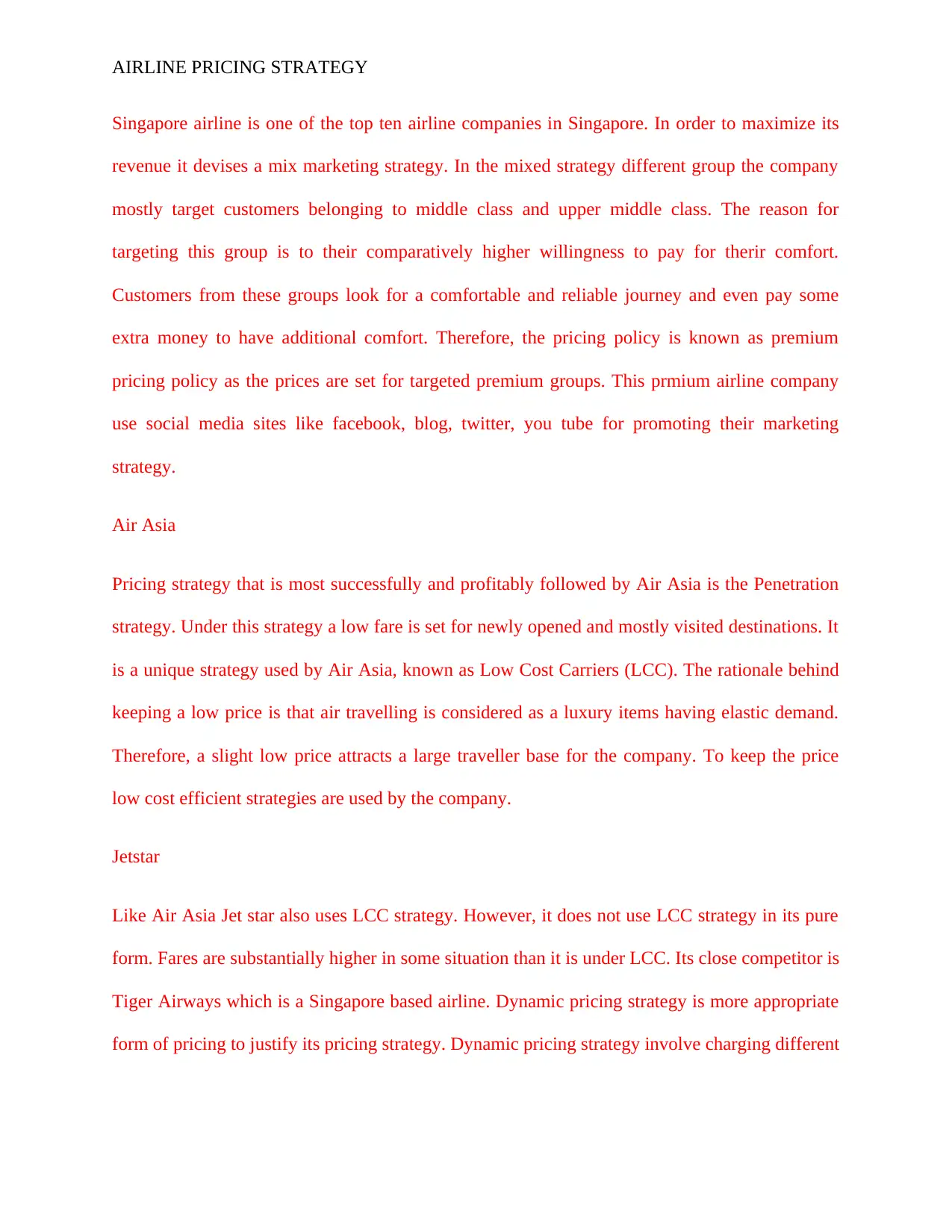
AIRLINE PRICING STRATEGY
Singapore airline is one of the top ten airline companies in Singapore. In order to maximize its
revenue it devises a mix marketing strategy. In the mixed strategy different group the company
mostly target customers belonging to middle class and upper middle class. The reason for
targeting this group is to their comparatively higher willingness to pay for therir comfort.
Customers from these groups look for a comfortable and reliable journey and even pay some
extra money to have additional comfort. Therefore, the pricing policy is known as premium
pricing policy as the prices are set for targeted premium groups. This prmium airline company
use social media sites like facebook, blog, twitter, you tube for promoting their marketing
strategy.
Air Asia
Pricing strategy that is most successfully and profitably followed by Air Asia is the Penetration
strategy. Under this strategy a low fare is set for newly opened and mostly visited destinations. It
is a unique strategy used by Air Asia, known as Low Cost Carriers (LCC). The rationale behind
keeping a low price is that air travelling is considered as a luxury items having elastic demand.
Therefore, a slight low price attracts a large traveller base for the company. To keep the price
low cost efficient strategies are used by the company.
Jetstar
Like Air Asia Jet star also uses LCC strategy. However, it does not use LCC strategy in its pure
form. Fares are substantially higher in some situation than it is under LCC. Its close competitor is
Tiger Airways which is a Singapore based airline. Dynamic pricing strategy is more appropriate
form of pricing to justify its pricing strategy. Dynamic pricing strategy involve charging different
Singapore airline is one of the top ten airline companies in Singapore. In order to maximize its
revenue it devises a mix marketing strategy. In the mixed strategy different group the company
mostly target customers belonging to middle class and upper middle class. The reason for
targeting this group is to their comparatively higher willingness to pay for therir comfort.
Customers from these groups look for a comfortable and reliable journey and even pay some
extra money to have additional comfort. Therefore, the pricing policy is known as premium
pricing policy as the prices are set for targeted premium groups. This prmium airline company
use social media sites like facebook, blog, twitter, you tube for promoting their marketing
strategy.
Air Asia
Pricing strategy that is most successfully and profitably followed by Air Asia is the Penetration
strategy. Under this strategy a low fare is set for newly opened and mostly visited destinations. It
is a unique strategy used by Air Asia, known as Low Cost Carriers (LCC). The rationale behind
keeping a low price is that air travelling is considered as a luxury items having elastic demand.
Therefore, a slight low price attracts a large traveller base for the company. To keep the price
low cost efficient strategies are used by the company.
Jetstar
Like Air Asia Jet star also uses LCC strategy. However, it does not use LCC strategy in its pure
form. Fares are substantially higher in some situation than it is under LCC. Its close competitor is
Tiger Airways which is a Singapore based airline. Dynamic pricing strategy is more appropriate
form of pricing to justify its pricing strategy. Dynamic pricing strategy involve charging different
⊘ This is a preview!⊘
Do you want full access?
Subscribe today to unlock all pages.

Trusted by 1+ million students worldwide
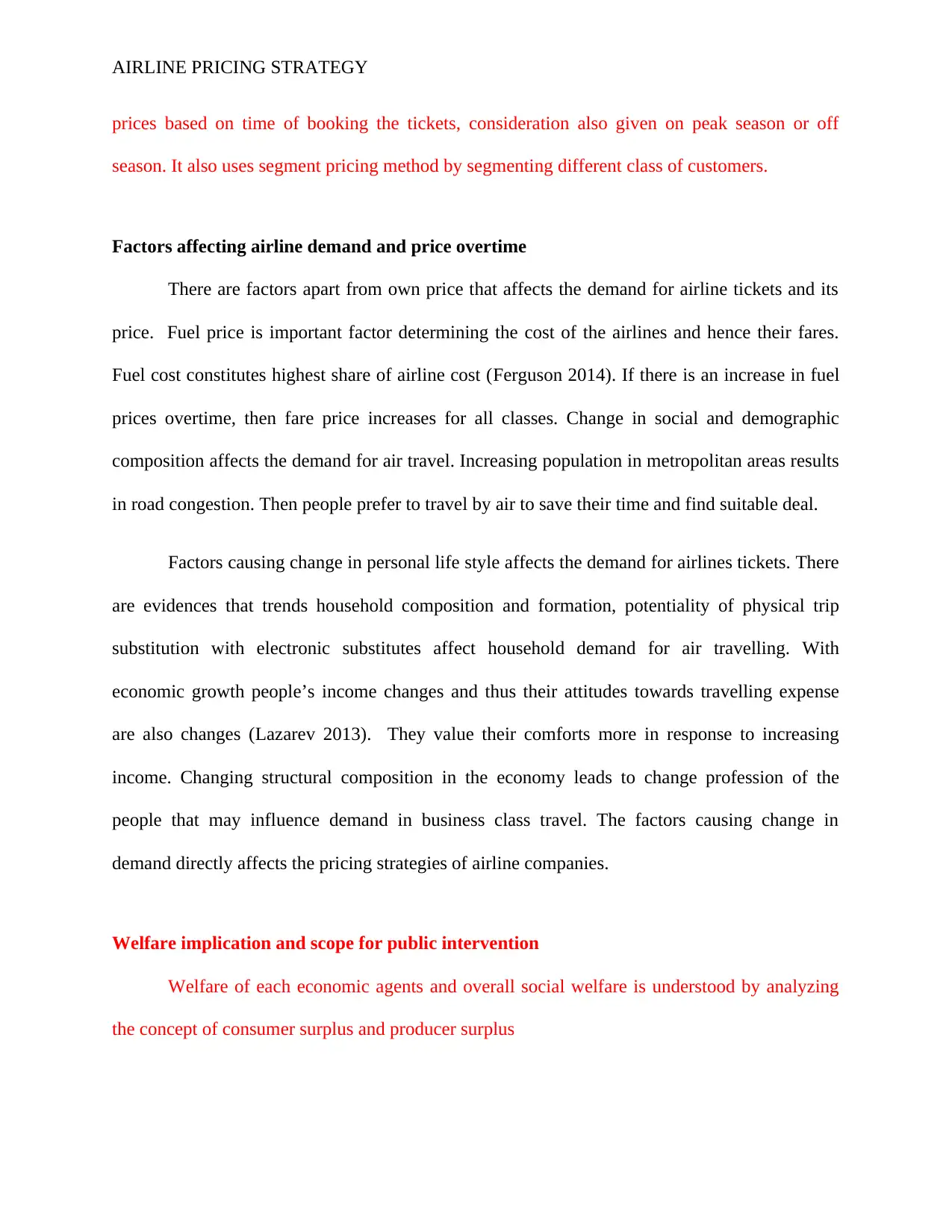
AIRLINE PRICING STRATEGY
prices based on time of booking the tickets, consideration also given on peak season or off
season. It also uses segment pricing method by segmenting different class of customers.
Factors affecting airline demand and price overtime
There are factors apart from own price that affects the demand for airline tickets and its
price. Fuel price is important factor determining the cost of the airlines and hence their fares.
Fuel cost constitutes highest share of airline cost (Ferguson 2014). If there is an increase in fuel
prices overtime, then fare price increases for all classes. Change in social and demographic
composition affects the demand for air travel. Increasing population in metropolitan areas results
in road congestion. Then people prefer to travel by air to save their time and find suitable deal.
Factors causing change in personal life style affects the demand for airlines tickets. There
are evidences that trends household composition and formation, potentiality of physical trip
substitution with electronic substitutes affect household demand for air travelling. With
economic growth people’s income changes and thus their attitudes towards travelling expense
are also changes (Lazarev 2013). They value their comforts more in response to increasing
income. Changing structural composition in the economy leads to change profession of the
people that may influence demand in business class travel. The factors causing change in
demand directly affects the pricing strategies of airline companies.
Welfare implication and scope for public intervention
Welfare of each economic agents and overall social welfare is understood by analyzing
the concept of consumer surplus and producer surplus
prices based on time of booking the tickets, consideration also given on peak season or off
season. It also uses segment pricing method by segmenting different class of customers.
Factors affecting airline demand and price overtime
There are factors apart from own price that affects the demand for airline tickets and its
price. Fuel price is important factor determining the cost of the airlines and hence their fares.
Fuel cost constitutes highest share of airline cost (Ferguson 2014). If there is an increase in fuel
prices overtime, then fare price increases for all classes. Change in social and demographic
composition affects the demand for air travel. Increasing population in metropolitan areas results
in road congestion. Then people prefer to travel by air to save their time and find suitable deal.
Factors causing change in personal life style affects the demand for airlines tickets. There
are evidences that trends household composition and formation, potentiality of physical trip
substitution with electronic substitutes affect household demand for air travelling. With
economic growth people’s income changes and thus their attitudes towards travelling expense
are also changes (Lazarev 2013). They value their comforts more in response to increasing
income. Changing structural composition in the economy leads to change profession of the
people that may influence demand in business class travel. The factors causing change in
demand directly affects the pricing strategies of airline companies.
Welfare implication and scope for public intervention
Welfare of each economic agents and overall social welfare is understood by analyzing
the concept of consumer surplus and producer surplus
Paraphrase This Document
Need a fresh take? Get an instant paraphrase of this document with our AI Paraphraser
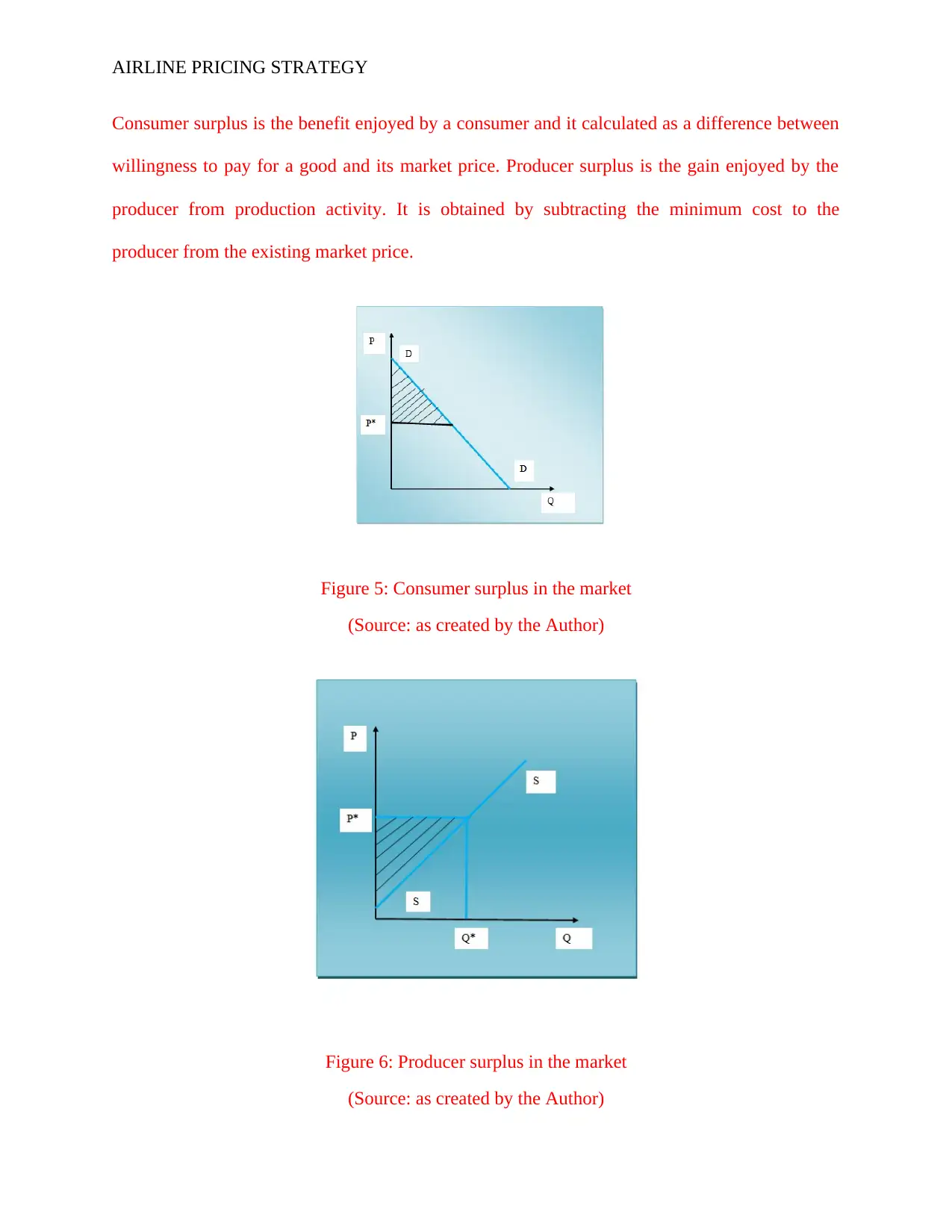
AIRLINE PRICING STRATEGY
Consumer surplus is the benefit enjoyed by a consumer and it calculated as a difference between
willingness to pay for a good and its market price. Producer surplus is the gain enjoyed by the
producer from production activity. It is obtained by subtracting the minimum cost to the
producer from the existing market price.
Figure 5: Consumer surplus in the market
(Source: as created by the Author)
Figure 6: Producer surplus in the market
(Source: as created by the Author)
Consumer surplus is the benefit enjoyed by a consumer and it calculated as a difference between
willingness to pay for a good and its market price. Producer surplus is the gain enjoyed by the
producer from production activity. It is obtained by subtracting the minimum cost to the
producer from the existing market price.
Figure 5: Consumer surplus in the market
(Source: as created by the Author)
Figure 6: Producer surplus in the market
(Source: as created by the Author)
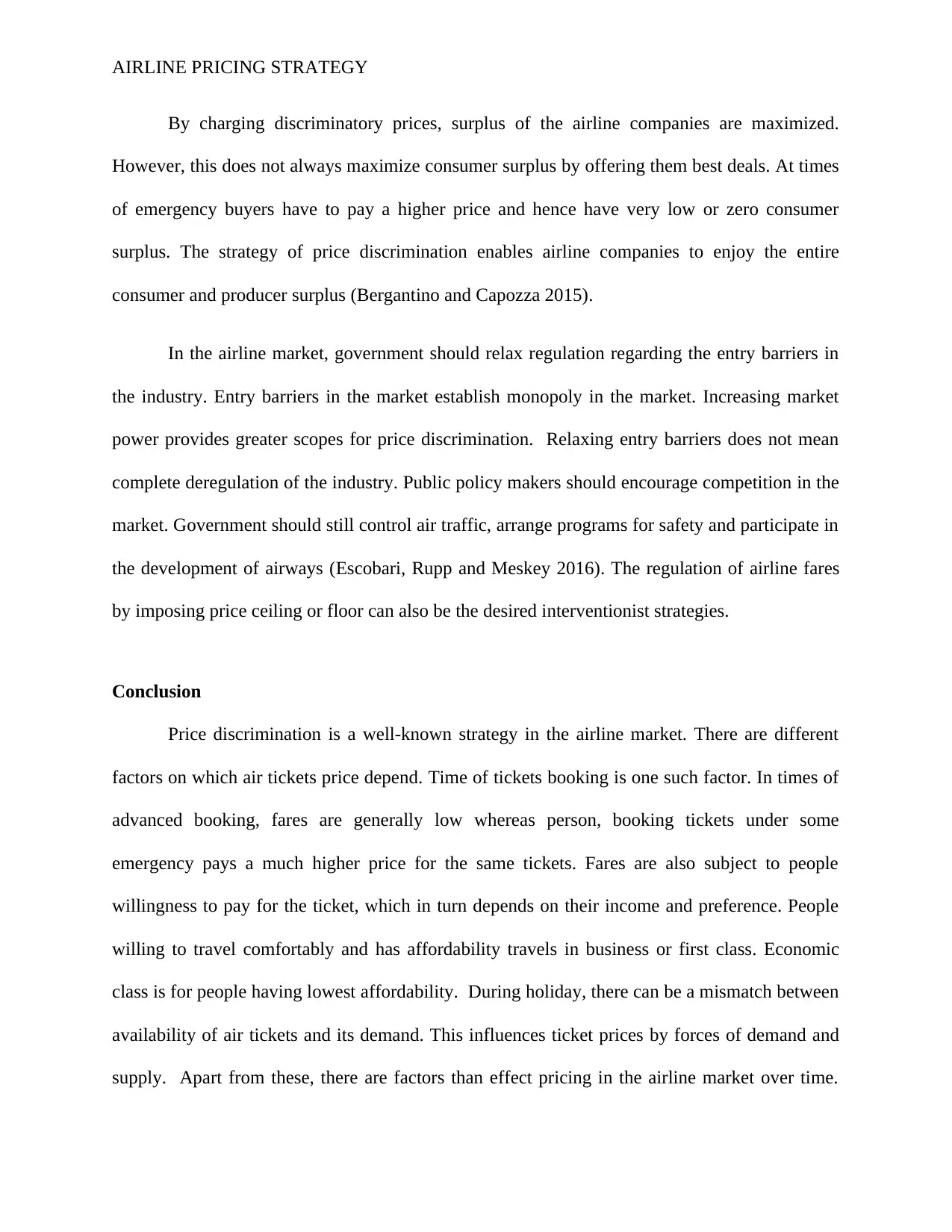
AIRLINE PRICING STRATEGY
By charging discriminatory prices, surplus of the airline companies are maximized.
However, this does not always maximize consumer surplus by offering them best deals. At times
of emergency buyers have to pay a higher price and hence have very low or zero consumer
surplus. The strategy of price discrimination enables airline companies to enjoy the entire
consumer and producer surplus (Bergantino and Capozza 2015).
In the airline market, government should relax regulation regarding the entry barriers in
the industry. Entry barriers in the market establish monopoly in the market. Increasing market
power provides greater scopes for price discrimination. Relaxing entry barriers does not mean
complete deregulation of the industry. Public policy makers should encourage competition in the
market. Government should still control air traffic, arrange programs for safety and participate in
the development of airways (Escobari, Rupp and Meskey 2016). The regulation of airline fares
by imposing price ceiling or floor can also be the desired interventionist strategies.
Conclusion
Price discrimination is a well-known strategy in the airline market. There are different
factors on which air tickets price depend. Time of tickets booking is one such factor. In times of
advanced booking, fares are generally low whereas person, booking tickets under some
emergency pays a much higher price for the same tickets. Fares are also subject to people
willingness to pay for the ticket, which in turn depends on their income and preference. People
willing to travel comfortably and has affordability travels in business or first class. Economic
class is for people having lowest affordability. During holiday, there can be a mismatch between
availability of air tickets and its demand. This influences ticket prices by forces of demand and
supply. Apart from these, there are factors than effect pricing in the airline market over time.
By charging discriminatory prices, surplus of the airline companies are maximized.
However, this does not always maximize consumer surplus by offering them best deals. At times
of emergency buyers have to pay a higher price and hence have very low or zero consumer
surplus. The strategy of price discrimination enables airline companies to enjoy the entire
consumer and producer surplus (Bergantino and Capozza 2015).
In the airline market, government should relax regulation regarding the entry barriers in
the industry. Entry barriers in the market establish monopoly in the market. Increasing market
power provides greater scopes for price discrimination. Relaxing entry barriers does not mean
complete deregulation of the industry. Public policy makers should encourage competition in the
market. Government should still control air traffic, arrange programs for safety and participate in
the development of airways (Escobari, Rupp and Meskey 2016). The regulation of airline fares
by imposing price ceiling or floor can also be the desired interventionist strategies.
Conclusion
Price discrimination is a well-known strategy in the airline market. There are different
factors on which air tickets price depend. Time of tickets booking is one such factor. In times of
advanced booking, fares are generally low whereas person, booking tickets under some
emergency pays a much higher price for the same tickets. Fares are also subject to people
willingness to pay for the ticket, which in turn depends on their income and preference. People
willing to travel comfortably and has affordability travels in business or first class. Economic
class is for people having lowest affordability. During holiday, there can be a mismatch between
availability of air tickets and its demand. This influences ticket prices by forces of demand and
supply. Apart from these, there are factors than effect pricing in the airline market over time.
⊘ This is a preview!⊘
Do you want full access?
Subscribe today to unlock all pages.

Trusted by 1+ million students worldwide
1 out of 15
Related Documents
Your All-in-One AI-Powered Toolkit for Academic Success.
+13062052269
info@desklib.com
Available 24*7 on WhatsApp / Email
![[object Object]](/_next/static/media/star-bottom.7253800d.svg)
Unlock your academic potential
Copyright © 2020–2025 A2Z Services. All Rights Reserved. Developed and managed by ZUCOL.





